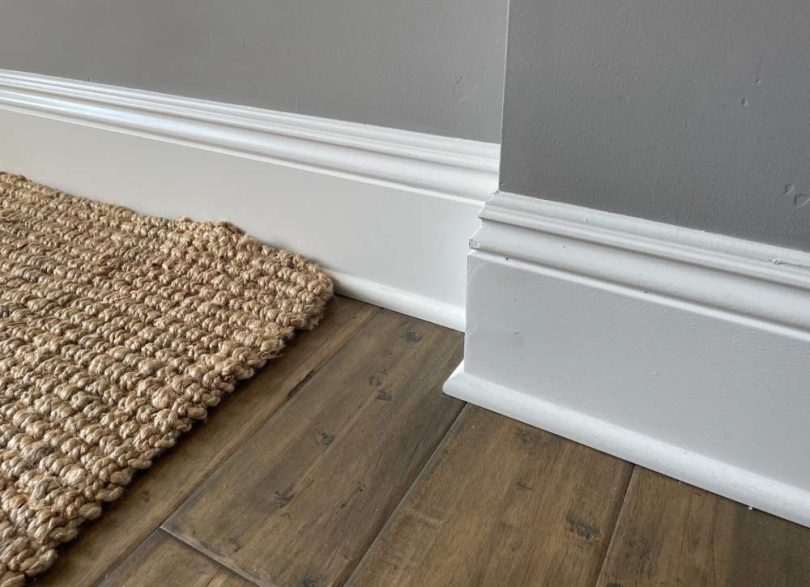Among the most popular methods of providing your home with a finished look is shoe molding. Shoe moldings have been used for centuries to decorate rooms and hallways. They add a decorative touch.
There are many types of shoe molding. Each has its own pros, cons, and differences.
Here we’ll share with you the different types of shoe moldings and which type is best for what application.
Different Types of Shoe Molding
1. PVC

Pros
- Cleans up easier
- Has a smoother look
- Cheaper than wood molding
Cons
- Plastic contains high levels of petroleum
- Is not eco-friendly
Finish
You can gain a modern look in your home with PVC molding. It appears more smooth, and joins are hardly seen.
Painting vs staining
PVC has a slick surface and doesn’t take to paint very well. The paint tends to bead up and drips. You can buy paint designed for this type of surface. PVC is not suitable for staining.
Water resistance
PVC shoe molding is waterproof and safe for use in wet and moist areas.
Fire-resistant
PVC trim is a fire retardant.
Durability
PVC has the tendency to break and may crack. It also doesn’t expand well when the structure moves.
Weight
PVC shoe molding is lightweight and easy to carry.
When to use
This type of molding is good for the door, and window surrounds, deck skirting, fascia, and soft fit trim.
Average cost
You can buy PVC molding for between $3 and $5 per linear foot
2. Vinyl
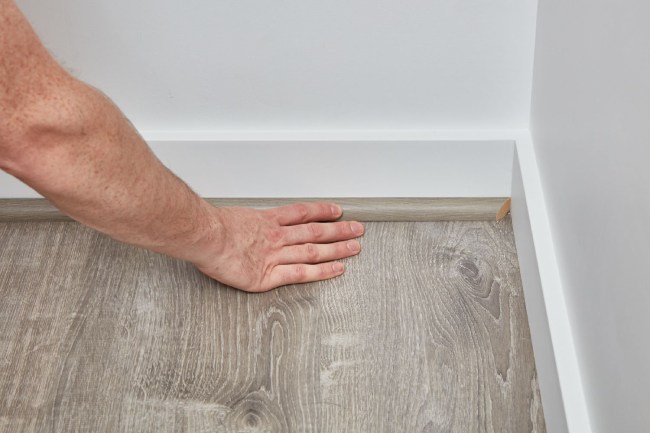
Pros
- It is easier to install
- Has flexibility
- Installs over crooked walls or askew angles
Cons
- Attracts mildew in moist conditions
- Environmental hazard with chemical content
- It is difficult to remove or replace during renovations
Painting vs staining
Non-porous baseboards don’t stain easily because of their non-porous characteristics. The paint won’t adhere either. The color can get customized to match the color scheme in your home.
Water resistance
This material can go in any room that has exposure to water. Its waterproofing properties make it a popular choice for modern kitchens.
Fire resistance
It is a natural fire retardant polymer and safe for use in higher fire areas.
Durability
The durability is not very high and the molding may dent easily.
Weight
This type of molding is lightweight and suitable for transport as it can bend if needed.
When to use
You should keep vinyl in mind if you plan to trim outdoors, floors, or ceilings.
Average cost
Vinyl shoe molding is available for around $1.15 to $3.50 per linear foot.
3. Medium-density fiberboard or MDF
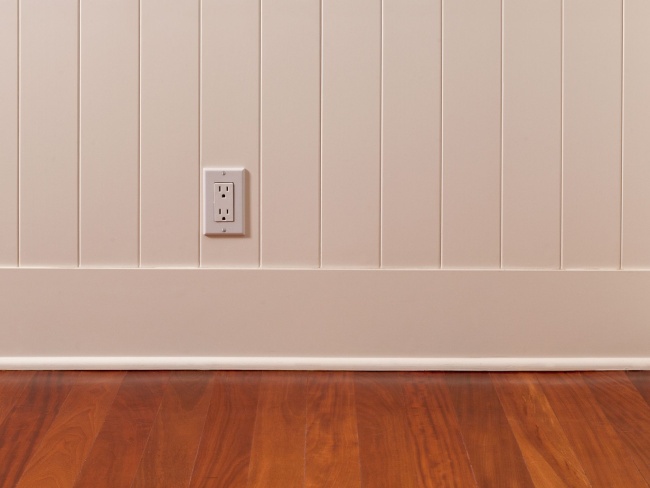
Pros
- Durable
- Extra strong by bonding together with resin
- Can handle scratches, foot traffic, and bumps
Cons
- Unappealing to look at it
- Cannot be stained
Painting vs staining
There is only one drawback – they do not stain well, limiting what shade they are available in. They can get painted.
Water resistance
MDF is slightly resistant to moisture. It is neither water-repellent nor waterproof and indirect contact with the elements will still swell and warp
Fire resistance
MDF fire retardant is a special low flame smoke developer and spreader. This is the better option to get instead of plain MDF with no fire-proof status.
Durability
This type is not very durable or strong but is resistant to all termites. You need to take care when handling and installing.
Weight
Regular weight and lightweight medium-density fiberboards are available.
When to use
The MDF is suitable for baseboards, different trim applications, and crown molding.
Average cost
This type of molding sells for $4- $6 for each eight-foot part.
4. Polystyrene
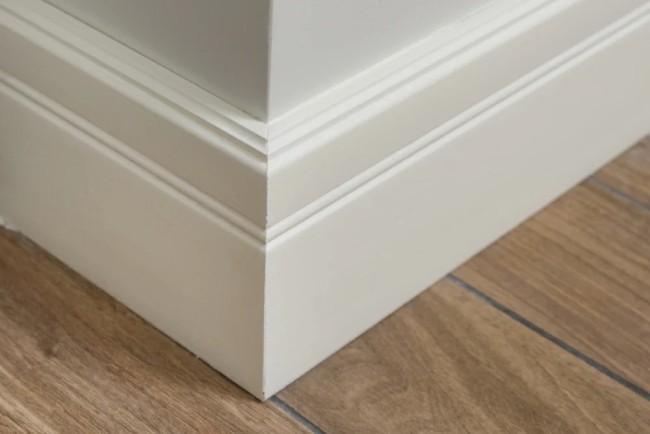
Pros
- There would be no need to use saws or lumbar to install
- Unlike wood, they do not rot when exposed to humidity
- Termites are no threat
Cons
- Dentswhen bumped
- Scratches easily
- Limited to short lengths
Painting vs staining
Prefinished polystyrene trim is available and it can get painted if desired. You will not be able to stain the plastic as the stain does not adhere.
Water resistance
This product is water-resistant. It is not harmed when installed in moist and wet areas.
Fire resistance
Polystyrene is flammable, unfortunately.
Durability
Polystyrene foam is resistant to dampness as a result of its nature. This makes it ideal for damp environments.
Weight
Transport and installation of moldings are much easier thanks to their light weight.
When to use
Polystyrene is for indoor and outdoor use. This is ideal for small kickboards and trims above the flooring.
Average cost
You are looking at $2.00 to $3.00 per linear foot for this molding.
5. Wood
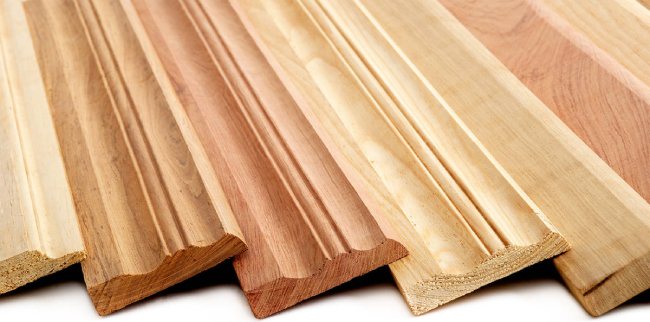
Pros
- Wood is renewable
- Flexible wood trim
- Durable
- Style yourself with a router
Cons
- Constant moisture can cause rotting and mold growth
- Costly
- Will need painting or coating or the material won’t stay raw
Finish
The wood can give you a rustic, country look.
Painting vs staining
Painting or staining is possible. Wooden trims have the most elegant appearance after varnishing and aging.
Water resistance
This trim is not fully waterproof although protective coatings can offer some water protection.
Fire resistance
Wood is not fire-resistant and shouldn’t be in high-risk fire areas.
Durability
Wood trim needs repainting at least every 4-5 years. It is durable and solid when coated in polyurethane since the paint doesn’t offer as much durability.
Weight
These trims use lightweight woods like hemlock or pine.
When to use
It can get used to cover up gaps and edges to give areas a cleaner look and for ornamental molding features.
Average cost
A wood crown molding costs an average of $1 to $6 per linear foot
6. Polyurethane

Pros
- Doesn’t rot, splinter, and crack
- Stronger than wood
- Insects are not attracted to polyurethane molding
Cons
- Some types are a slightly softer wood
- Candent easily
- You cannot stain it
Painting vs staining
You can maintain the beauty of molding by painting it but remember that staining doesn’t work on this type of molding.
Water resistance
This material is highly waterproof. In fact, you can even place it in water for ages and it will remain fine.
Fire resistance
Polyurethane isn’t damaged by heat until temperatures reach 700 degrees.
Durability
This shoe molding is strong like wood and you don’t need to worry about damage or broken bits that need repairing.
Weight
In the case of polyurethane molding, the weight per meter is only 0.5 kg.
When to use
This material is suitable for any room in a home, especially for bathrooms and laundry due to its moisture resistance capability.
Average cost
To install polyurethane molding, you will have to pay $5 to $10 per linear foot
Standard vs Decorative Shoe Molding: Is There Any Difference?
There are two basic types of shoe molding: decorative and basic.
a) Decorative shoe molding
Decorative molding offers a variety of color, shape, and pattern options.
b) Basic shoe molding
Generally, basic shoe moldings are narrower and are not as flashy.
c) Shoe molding sizes
- Length: show molding length comes in sections of 8 feet
- Height: varies between 3/4-inch up to 1-inch in height
- Width: varies from 7/16 inches to ½ inch
FAQs
1. Do baseboards need shoe molding?
Ans. Shoe molding gets its name from the fact it is set at shoe level. You don’t always need shoe molding with baseboards; it’s a personal choice. The main goal of both baseboards and molding is to hide the transition from the floor and the bottom of the wall.
2. Should shoe molding match the floor or cabinets?
Ans. Walls without cabinets have shoe moldings that match the floor as close as possible. Cabinets should match the shoe molding around them. I would also match the baseboards with the shoe molding if doing that around the baseboards.
3. Should I paint shoe molding before installing?
Ans. Painting the trim before installing is what many experts advise. It’s an easy and fast method that can speed up the painting process.
4. What color should shoe molding be?
Ans. Since white color dominates and it is quite neutral, most shoe molding is white. You can choose a custom color if you prefer.

